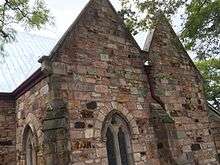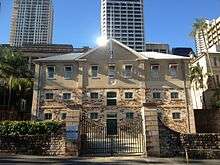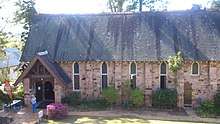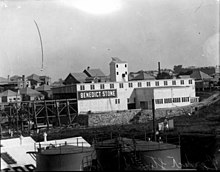Brisbane tuff
Brisbane tuff is a type of rock,[1] formed as a result of a volcanic eruption. As the name suggests, it is a type of tuff found in Brisbane, Queensland, Australia.[2] It is a form of welded ignimbrite.[3] Brisbane tuff comes in a variety of colours: pink, green, blue (grey) and purple.[4] The different colours are due to the extent of oxidation of iron and manganese.[5]

History
Brisbane tuff began to be used during the period when Captain Patrick Logan was the commandant of the Moreton Bay penal colony.[6]
Brisbane tuff is found in various parts of Brisbane and was quarried extensively in the early history of Brisbane at the Kangaroo Point Cliffs and the (now) Windsor Town Quarry Park for use in construction of Brisbane's earliest buildings.
Geology
Brisbane tuff was formed by the compaction of volcanic ash more than 226 million years ago. It displays pyroclastic flows of rock fragments deposited as the volanic ash was forming. Layers of Brisbane tuff can be over 50 metres (160 ft) thick.[6]
It is a form of welded ignimbrite.[3] Brisbane tuff comes in a variety of colours: pink, green, blue (grey) and purple.[4] The different colours are due to the extent of oxidation of iron and manganese.[5]
Construction
Brisbane tuff has been used in the construction of the following Brisbane buildings, many of them now heritage-listed:
- Commissariat Store
- Cathedral of St Stephen
- Old Bishopsbourne Chapel (also known as Chapel of the Holy Spirit)
- St Martin's House
- St Mary's Anglican Church, Kangaroo Point
- Manor Apartment Hotel (former Colonial Mutual Life building) using Benedict stone
 Commissariat Store
Commissariat Store St Stephen's cathedral
St Stephen's cathedral Old Bishopsbourne Chapel
Old Bishopsbourne Chapel St Martin's House
St Martin's House- St Mary's Anglican Church, Kangaroo Point
Benedict stone

Benedict stone is a mixture of cement and crushed Brisbane tuff used on building facades as an alternative to full stone construction. It was manufactured by Benedict Stone (Qld) Pty Ltd which was established by Roman Catholic Archbishop of Brisbane, James Duhig, to manufacture the stone required for the Holy Name Cathedral, Fortitude Valley. The product was developed at the turn of the twentieth century by American manufacturer, Benedict. Duhig obtained a licence from America and opened the Benedict Stone works at Bowen Hills on 9 August 1929. In February 1930 Colonial Mutual Life (CML) advanced Duhig a £70,000 mortgage on his properties which included the stone works. A mutually-dependent relationship developed between CML, Duhig and Jack Hennessey, architect. CML used Benedict stone to build a number of their Australian offices, ensuring some of their mortgage was repaid and employed Hennessey and Concrete Constructions (Qld) Ltd, Brisbane (Duhig's architect and contractor for the Holy Name Cathedral).[7]
Tunnelling
The extent and hardness of Brisbane tuff deposits has often been a barrier to building tunnels in Brisbane due to its 100–150 megapascal strength. However, since 2007, advances in tunnel-boring equipment with tungsten carbide cutting heads has enabled a number of major tunnels to be constructed in Brisbane, e.g. the Clem Jones Tunnel which passes through the Kangaroo Point area.[8]
References
- Briggs, Cecily (1929). "The Brisbane tuff". Proceedings of the Royal Society of Queensland. 40 (12): 147–164 – via Biodiversity Heritage Library.
- Richards, H. C. and Bryan, W. H. (1933). "The problem of Brisbane tuff" (PDF). Proceedings of the Royal Society of Queensland. 45 (11): 50–65 – via UQ eSpace.
- "Brisbane Tuff". Windsor and Districts Historical Society. Retrieved 2 June 2014.
- "Products". Queensland Heritage Masonry Pty Ltd. Archived from the original on 7 June 2014. Retrieved 2 June 2014.
- Thomas, Glenn S. (1999). "Porphyry, tuff and loose specifications" (PDF). Landscape Australia. 21 (2): 124–126. Retrieved 3 June 2014.
- Hinchliffe, Jessica (14 July 2020). "How 226-million-year-old tuff rock formed the foundations of Brisbane". ABC Radio Brisbane. Retrieved 15 July 2020.
- "Newspaper House (entry 600150)". Queensland Heritage Register. Queensland Heritage Council. Retrieved 1 August 2014.
- Burke, Edmund (15 July 2007). "Tuff rock? No problem". The Sunday Mail. Retrieved 3 June 2014.
External links
![]()